Målade väggar och tak blir alltmer populära. Men förberedelserna inför målningen är en utmaning. Färgen visar alla fel och oegentligheter och det tar lång och smärtsam tid att göra det. Förenkla uppgiften, och samtidigt och göra väggen lättnad kan vara med hjälp av tapeter från glasfiber. De är utformade för målning och mycket långvarig. Hur man limmar glasfiber tapeter och vi kommer att diskutera vidare.
Innehåll i artikeln
Vad är glasfiber tapeter
Glasfibertapet är ett ytbehandlingsmaterial för väggar och tak. Oftast används för målning. Från glasfibrer på speciella maskiner vävar dukar, som kallas "glas tapeter". På grund av användningen av fibrer av olika tjocklekar och deras olika väv får olika mönster. De är inte så många som på vanlig tapeter, de är inte för uttalade. Och detta anses vara en av nackdelarna med detta efterbehandlingsmaterial. Men praktisk, hållbarhet och förmågan att måla om dem upp till 20 gånger uppväger denna nackdel.
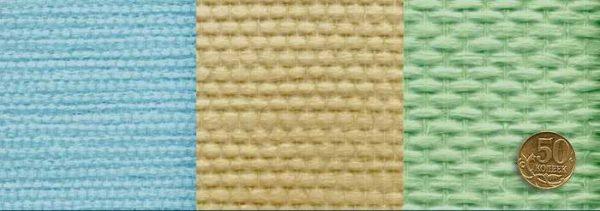
Ritningar där är nästan omärkliga, som efter målning bara ger en något grov yta. Den vanligaste typen - corduroy. Namngiven så eftersom väven är gjord på samma sätt som tidigare vävd grov trasa - cuckold. Det är det små, medelstora, stora. Skillnaden kan ses på bilden.
Utbredda är fortfarande fiskbens-, schackbrädes- och rombmönster. De har också små, medelstora och stora. De skiljer sig åt i mönstrets "omfattning". Förutom dessa typer finns det andra vävningar, men de tillhör redan kategorin författarens eller samlarobjekt och kostar mer.
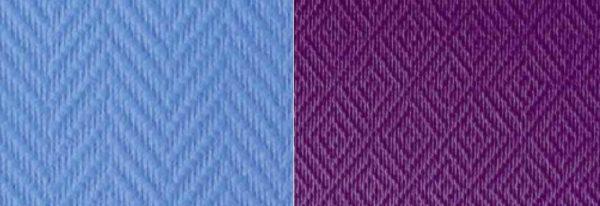
Detta material säljs i rullar, bredden är vanligtvis 1 meter. Rullens längd - från 12,5 meter (det finns också 50). Priset per rulle - från 20$ till 50$. Kostnaden beror på längden på materialet i rullen, mönstrets komplexitet, tillverkaren.
Fördelar och nackdelar
Innan vi limmar glas tapeter, låt oss förstå deras för- och nackdelar. Låt oss börja med proffsen. De är gjorda av naturliga råvaror, säkra, miljövänliga, stöder inte förbränning. Kännetecknas av ökad hållbarhet, livslängd - från 10 till 30 år. Lämplig för målning, vilket gör att du snabbt kan ändra interiören. De kan målas om utan att ändra sitt utseende från 5 till 20 gånger (beroende på kvalitet).
Glastapet gör det lättare att förbereda ytan för målning. Väggarna ska vara jämna, men inte idealiska - alla små avvikelser kommer att dölja glasfiberväven och relief tapeten. Och detta är ett betydande plus.
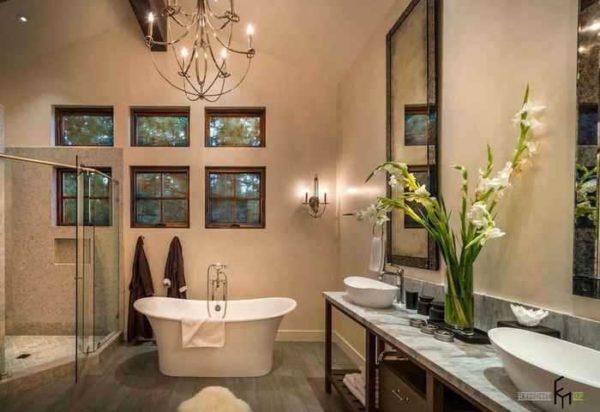
En annan positiv punkt - de är inte rädda för hög luftfuktighet, så de kan användas i badrummet och i köket. Det är bara nödvändigt att välja lämplig färg.
Nackdelarna är följande:
- Inte så stort sortiment som konventionell tapet. Veshny-utseendet kan diversifieras genom att dekorera väggarna, tapetserade med glasfiber tapeter, olika designtekniker.
- Glasfiber när du limmar prickar, måste du arbeta i skyddskläder.
- Priset är högre än den vanliga vackra tapeten.
I allmänhet inte ett idealiskt alternativ, men om du behöver en hållbar yta med möjlighet att snabbt ändra färg - limglas tapet - ditt val.
Hur man väljer
Vanligtvis väljer glas tapeter på mönstret, och kvaliteten bestäms av densiteten hos materialet i rullen. Men det bör sägas att inte alla på väggen ser lika voluminösa ut som i rullen. För att få bilden att se tydligare ut använder vissa tillverkare lösa trådar. När du limmar på väggen pressas allt ludd ner, volymen går. Så volymen i rullen - inte en garanti för att bilden kommer att vara tydligt synlig på väggen. Vägen ut är att köpa beprövade varumärken som garanterar en viss kvalitet.
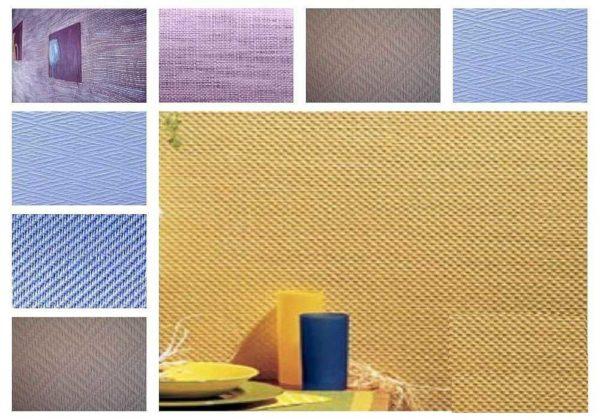
Praktiskt taget detsamma är fallet med densiteten hos glas tapeter "att ta på". För att ge dem ytterligare styrka impregnerar vissa tillverkare tyget med stärkelse. Vid limning från limet suger denna impregnering, ytan visar sig lös, på grund av vilken den absorberar en stor mängd färg.
Titta på de tekniska egenskaperna
Hur man bestämmer i det här fallet bra glas tapeter? Titta på de tekniska specifikationerna. Det finns en linje där - densitet. Ju större siffran är, desto tätare är tapeten (normal densitet - cirka 145 g/m2). Om det inte finns någon sådan indikator är det rullens vikt som gäller. Även i detta fall - ju tyngre rullen är, desto större är materialets densitet. Men när det gäller vikt bör du också titta på längden på tyget i rullen - det kan vara väldigt annorlunda - från 12,5 meter till 50. Det finns en annan väg ut - lita på beprövade tillverkare eller prova på en liten bit - lim, sedan måla. Endast frågan om var man ska ta den här biten förblir öppen ...
Vad mer är värt att veta om glas tapeter ... att de finns i två sorter - den första och den andra. Den första klassen - bra kvalitet, de har vanligtvis en garanti. Andra klass - något som ett lotteri. Kan inte vara någonting, kan vara dåligt limmad, ha ett stort antal defekter etc.
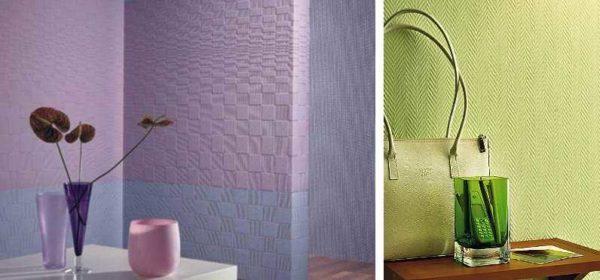
Några ord om äktenskap. Det förekommer även hos bra tillverkare - trasiga trådar, lägg fel, etc. Denna plats är markerad på en av kanterna på rullen limmad svart remsa, och till rullens längd läggs 50 cm (straff). När du köper en rulle i transparent förpackning, inspektera ändarna. Ju mindre svarta "markörer", desto lättare blir det när du skär.
Tillverkare
Och slutligen om beprövade tillverkare. Vi kan definitivt rekommendera varumärkena Wellton (Wellton) och Oscar (Oscar). Varje samling, varje rulle de har god kvalitet. Även andra klass handlar inte om kvalitet utan om icke-standardlängd (så att du kan spara pengar).
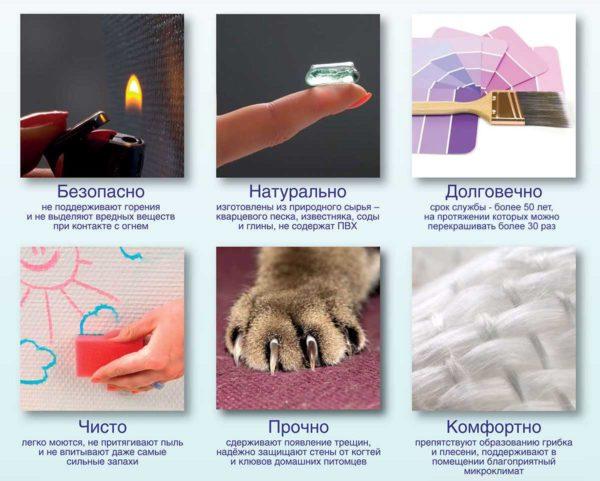
Om prissättningspolicyn: Welton - dyrare, valet av mönster mer, du kan omfärga upp till 20 gånger; Oscar - billigare, mindre texturer, du kan omfärga upp till 10 gånger. Så det finns ett val för varje handväska.
Hur man limmar glas tapeter
Glasfiber tapeter för att måla lim på ett speciellt lim eller PVA och dess analoger. Vanligt tapetlim kommer inte att gå, du bör inte försöka. Om det här är din första upplevelse är det bättre att ta en speciell komposition, och inte i pulver, och redo, i en hink. Ja, det är dyrare, men kvaliteten är garanterad, lim blir lättare, problem - mindre.
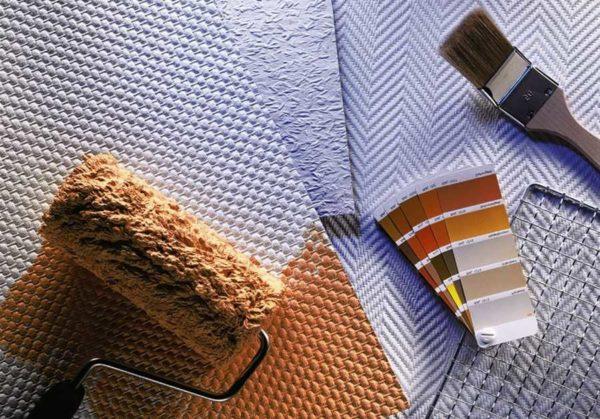
Ytbehandling
Innan du limmar glas tapeter, du måste förbereda väggarna eller taket. Väggarna ska vara jämna, utan gropar, utsprång. Ta bort fläckar, damm, det är önskvärt att täcka med primer. Som en primer är lämplig utspädd 1 till 10 PVA. Denna komposition appliceras på väggarna med en rulle, vänta tills den torkar och börja sedan limma glasbakgrunden.
Några tips om förberedelser för limning av olika underlag:
Som du har insett, när du förbereder basen är det viktigt att täta betydande fördjupningar, ta bort utsprång. Du kan inte uppnå en helt plan yta, som under målning, men betydande skillnader är synliga. Därför slätas de ut med sandpapper. Om det finns sprickor, de kan inte fyllas, och innan du applicerar kittlim förstärkningspapper (som används för gips).
Limning av glastapet
Nu specifikt om hur man limmar glas tapeter. Processen i sig skiljer sig inte från limning av konventionell - vinyl, akryl etc. Teknikerna och sekvensen är desamma. Det speciella är att limet endast appliceras på väggen, tapetduken är inte utsmetad. Annars är allt detsamma:
- På väggen eller taket appliceras lim jämnt. Det går snabbare att göra det med en rulle, i hörnen och fogarna med tak och vägg använder du en smal borste. Limmet ska fördelas jämnt. Där det kommer att finnas för mycket av det kommer "dips" att bildas och handavtryck kan vara synliga. På platser där det inte finns tillräckligt med lim kommer glas tapeter inte att fastna, en bubbla kommer att bildas. Så länge tapeten inte är målad syns inte bubblan, den känns bara för hand (efter torkning). När du målar dyker de alla upp. Därför försöker vi fördela limet jämnt över hela ytan.
- Klipp till tyget längs med väggens längd + en liten marginal (5-10 cm).
- Den första remsan av glas tapet är limmad på väggen strikt vertikalt. Kantens vertikalitet kontrolleras (bättre med en lodlinje). Tyget slätas ut med rörelser från mitten, till kanterna - så luften försvinner bättre. Det är önskvärt att använda en tapetspatel av plast. Det är bekvämt och snabbt att arbeta med det.
Överflödig längd (upptill och/eller nedtill) skärs bort. Lägg en stållinjal eller en bred spatel på rätt plats, ett vasst blad eller en brevpapperskniv skär glasfibern.
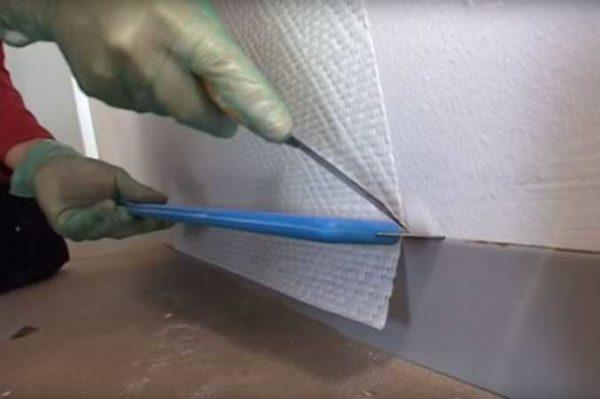
Limma fast den andra duken
Nästa tyg limmas rumpa mot rumpa. Den appliceras på kanten av den redan limmade och justerar mönstret. Därefter jämnas den ut till ytan först med händerna och sedan med en spatel. Använd en rullande rulle för limning av fogen bör inte användas - den "rullar" mönstret, och knocken är ännu mer framträdande. För hand kombineras tyget ganska bra.
Vid limning av det yttre hörnet finns det två alternativ:
Vid limning av det inre hörnet är tekniken vanligtvis densamma. Den sista duken på väggen ska gå på nästa vägg med 1-2 cm. Om den är bredare skärs den. Så det är lättare att lägga glas tapeten även om hörnet är ojämnt. Nästa remsa limmas överlappande. På det här stället får du ett dubbelt lager, men vanligtvis är det nästan omärkligt. Om du verkligen inte gillar det kan du göra lite mer än 3-4 cm, limma överlappning och sedan klippa bort överskottet från hörnet 1-2 cm.
Avsluta de små sakerna
På de ställen på väggen där det finns uttag fungerar strömbrytare med strömmen avstängd. Det är bäst att koppla bort den automatiska effektbrytaren på växeln. Ta bort de yttre delarna av uttag och strömbrytare, limma duken. På platsen för utgången av det elektriska nätverket skärs glasfleece tvärs över. Ta en spatel och applicera på utloppet. skär av överskottet med en kniv, tryck väl.
Medan du limmar glasfiber tapeter för målning och medan de torkar, det ska inte finnas något drag i rummet. Det är också värt att gardinera fönstret så att solen inte torkar ytan (bubblor kan bildas).
Du har förmodligen redan insett att om du åtminstone en gång har klistrat in vanlig tapet, vet du exakt hur man limmar glas tapeter. Eftersom det nästan inte finns några särdrag. Allt är detsamma. Funktioner börjar senare - väggen måste målas. Det är det som är ovanligt.
Hur man limmar glas tapeter berättas i videon. Allt är tillgängligt och förståeligt.
Färg för glasfiber tapeter
Hur man limmar glasfiber tapeter du vet, låt oss ta itu med vad och hur man målar dem. Oftast för målning av glasfiber tapeter använder vattenemulsion och vattendispersionsfärger. Akryl- och latexdispersioner tvättas väl, vissa - med en pensel och med användning av tvättmedel. Vissa sådana kompositioner tål tusentals tvättcykler med en borste (vandalresistent upp till 20 000). Därför kan de användas även i rum med aktiv användning - i korridoren, korridoren, köket, badrummet.
Vattenemulsioner är också tvättbara, men de är inte lika stabila. De kan i bästa fall torkas av några gånger med en fuktig trasa. Men de minskar inte väggarnas ånggenomsläpplighet. Därför målas de oftare i bostadsområden.
Det finns också speciella emaljer som är utformade för att måla tapeter. De är också bra, men är dyrare. När du väljer var uppmärksam på användningsområdet - det bör finnas en inskription att denna komposition är lämplig för tapeter (eller glas tapeter).
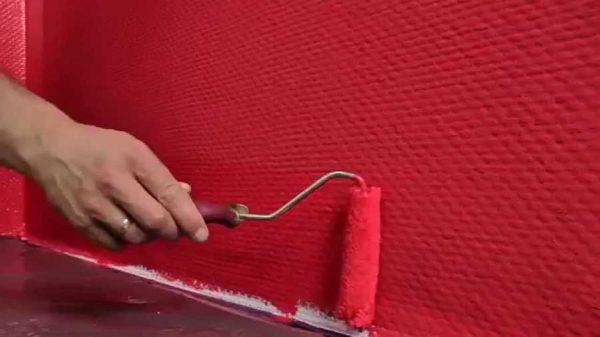
Hur tjock färg behövs? I princip spelar det ingen roll. Om det är flytande måste du applicera fler lager, om det är tjockt - mindre. I vilket fall som helst, för att få en bra effekt, kommer samma mängd torrsubstans att behövas. En annan sak är att ibland tjockare är mer gynnsamma, även om de kostar mer. I det här fallet är det nödvändigt att titta på täckkraften och det erforderliga antalet lager.
Egenskaper för färg för glasfiberduk
Var uppmärksam på vilken typ av yta som erhålls genom målning. Silkeslen matt färg kommer bäst att betona lättnaden, och bara matt färg kommer delvis att dölja den.
Det finns ytterligare en punkt. Glas tapeter - ett poröst material och färgförbrukning, särskilt när du applicerar det första lagret - stort. För att minska det, är det önskvärt att grunda dem. Som en primer kan du använda den grundläggande färgen, utspädd 1 till 1 vatten (om färgen är vattenbaserad). Dess döljkraft blir lägre, men på grund av den stora mängden vatten kommer den bättre att tränga in i porerna. Pigmentet kommer att fylla dem när det torkar. Nästa lager med "normal" densitet kommer att ligga bättre, det kommer att absorberas mindre. Detta, om än inte särskilt mycket, kommer att minska den totala färgförbrukningen.

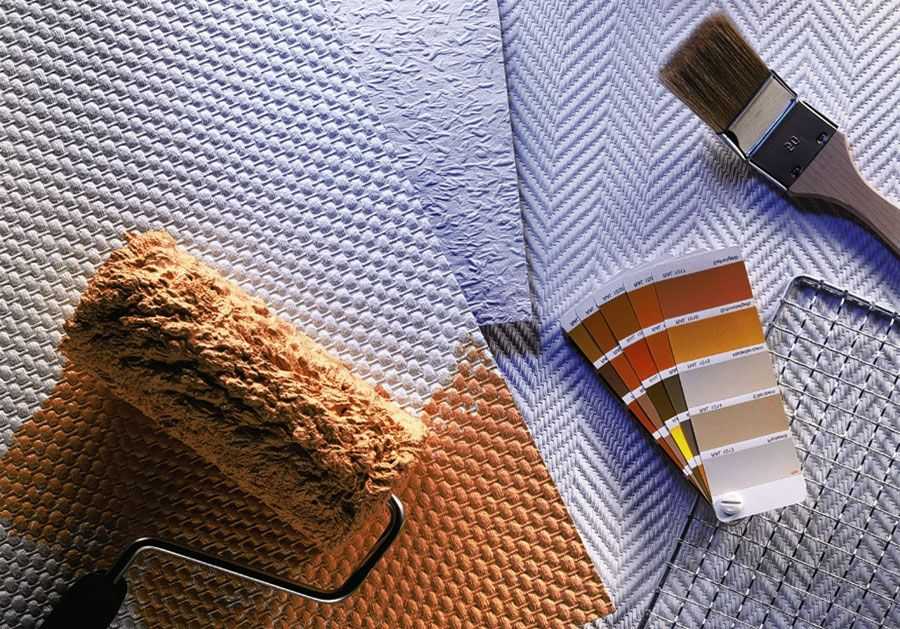
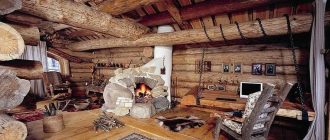
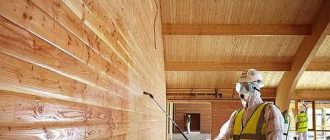
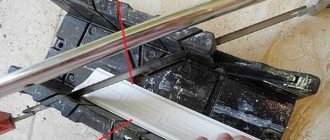
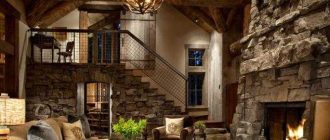
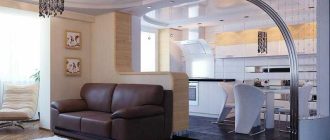
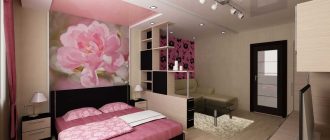
Hey, I recently tried gluing fiberglass wallpaper, and it was a game changer! Just make sure you prep the walls properly and use the right adhesive. Trust me, the result is worth it! Your space will look super fresh and modern. Give it a go!